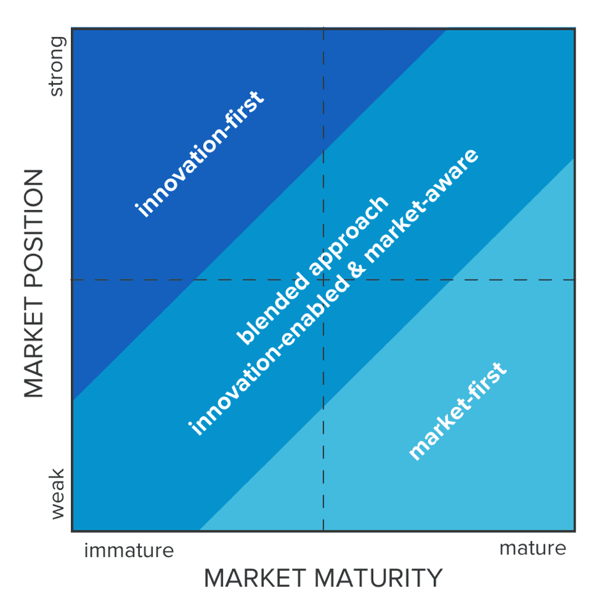You hear statements like “We don’t have any competitors” or “I never think about the competition” so often from so many business leaders that they’ve become cliche. Ignoring any ulterior motives these leaders might have, the sentiment echoes a common tension in companies. How do you pay attention to the competition and not lose sight of your unique strengths?
The challenge often starts in the C-suite. From there, it percolates down to functional teams that have different answers to the same question. A fundamental disagreement about how to approach the market can damage key relationships and the company culture, so it’s best to address it early.
Let's take a look at the differences in an innovation-first and market-first approach, why a business may be biased in one direction, and how to find the best balance for your company's growth.
Innovation-First vs. Market-First Companies
To start, it's helpful to dig into a company's background in order to see why they may be more innovation- or market-focused. Innovation-first companies frequently have a leader with a background in product development or R&D. They see the world through the lens of “what” they make. They admire breakthrough discoveries that give birth to new markets and change lives.
Ready to get started? Download your free competitive analysis template
Market-first companies tend to have executives with sales and marketing backgrounds. They have learned that innovation doesn't last, so success starts and ends in the trenches. The potential for one perspective to dominate drives many investors to seek out co-founders from both camps.
Public communication from executives may tell you whether the organization is more innovation-first or market-first. Budget priorities and important decisions are likely to reveal who truly holds the reins. A company that whiplashes the product roadmap based on the latest hot request from sales reps has swung too far to market-first. A company that launches new products without understanding the impact on customer relationships relies on innovation at all costs.
The Influence of Market Maturity and Position
Before you get too deep into the joys of change management, you should consider how your market shapes the balance.
The maturity of your market and your position in it can bias a company to a particular mindset. For instance, a company that dominates a market has less incentive to study what competitors are doing. They have the luxury of freedom, and sometimes that develops into myopia. On the other end of the spectrum is a smaller player in an established space. Any big competitive moves may cause sales to miss its numbers, product to lose focus, and more. In this scenario, market responsiveness and execution will win the day.

Most companies fall between those poles, but the culture may push them to one end. But you should foster a healthy paranoia even when you own the space. You should make time for innovation even when you're playing catch up. Otherwise, when the inevitable change in the market comes, you won't have the capacity to adjust your game.
The Influence of Business Type and Other Factors
Another dimension that can alter a company’s inclinations is the business type. Business to Business (B2B) and Business to Consumer (B2C) companies face different market pressures and opportunities. Often those intersect with the market position and maturity in complex ways. To overgeneralize, it can be more difficult to innovate in B2B because of complex implementations and the challenge of driving organizational change. That said, responding to competitive features in B2C companies can backfire, especially with a diehard fan base that likes your product just the way it is, thank you very much.
Some other variables that may influence the company to lean toward innovation or market needs in its approach include:
- Number/breadth of products: Having more products encourages innovation in each product line. Having fewer, more monolithic products creates barriers to innovation.
- Interdependency of products: Relationships between products tempers innovation because of the challenges of coordinating across products.
- Product integration strategy: Strong reliance on partner products discourages innovation in those product lines for similar reasons.
- Customer acquisition profile: Companies that prioritize acquisition tend to value innovation as a primary differentiator.
- Customer retention profile: Companies that prioritize retention combat customer churn with competitive responses.
The Solution: Using Market Knowledge to Balance Your Go-to-Market Approach
If your company leans too heavily towards following the market or trying to innovate, you can seek more balance with the help of market research. Without a deep understanding of what other companies are doing, you have no measuring stick for your own business.
Take the market-first organization, for example. Although they might focus too much on reacting to competitive developments, they at least have a very close eye on what's happening. So making the shift towards the innovation only requires a shift in mindset. Train sales and customer success reps to react to a hot competitive feature to change the conversation. They can pivot the discussion to the value that the customer sees in it. The possibilities may have wowed the customer so much that they didn’t consider the full impact deeply enough. Or a discussion might open up about larger challenges that the organization is facing that your offerings can address.
For product teams in market-first companies, resist the urge to rush to a direct competitive response. You can step back to ask if there's a way to innovate and leapfrog the competitor with a more powerful solution. In market-first companies, the realm of possibility can become too narrow, focused entirely on what competitors are doing. One way to break through this barrier is to follow innovators in unrelated spaces and use that to change the discussion.
In innovation-first companies, you can change the conversation by defining the larger pattern of innovation. Small developments are part of a larger pattern of innovation. Look for the larger strategy that drives small competitive updates. Rather than calling attention to a competitive feature that innovators might dismiss as insignificant, combine it with other moves by that competitor to outline how they’re innovating. Your research can also identify innovations in neighboring markets to create an appetite for more information about what direct competitors are doing.
With a deeper understanding of how your company should approach the market and the existing culture, you can develop a more coherent plan to create a balance between market awareness and focus on innovation. The state of go-to-market zen leads to better priorities and business decisions. Your most powerful weapon is understanding your audience and finding new ways to persuade them.




